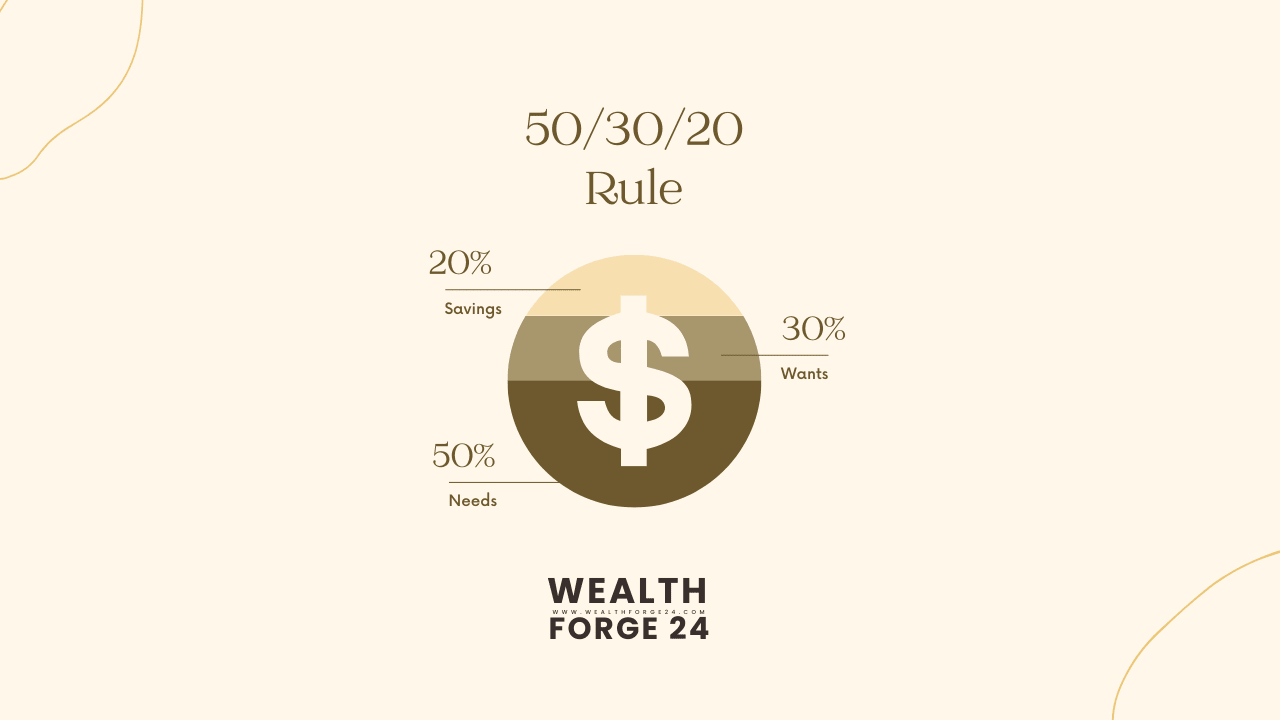The 50/30/20 Rule: What is it?
The 50/30/20 rule shows how to divide your after-tax income into three parts: 50% for wants, 30% for needs, and 20% for savings. U.S. Sen. Elizabeth Warren popularized the 50/30/20 budget rule in her ebook, “All Your Worth: The Ultimate Lifetime Money Plan.”
This simple rule helps you create a budget that you can follow for years. It’s a smart way to meet your financial goals.
Key Takeaways
- The 50/30/20 rule says to spend 50% of your after-tax income on wants and needs.
- Spend 30% of your profits on things you want but don’t need. Then, set aside 20% for savings.
- The rule serves as a template; it is supposed to help people control their coins.
- It balances purchasing necessities with saving for emergencies and retirement.
- To follow the 50/30/20 rule, you can simplify things. Set up automatic deposits and payments. Also, track your profit changes.
Important
A great budgeting app helps you track your income and spending. This makes following the 50/30/20 rule easier.
50%: Needs
Needs are payments you must make and purchases vital for survival. In this finances plan, 1/2 your after-tax earnings is allocated to cover those desires and obligations.
Needs consist of:
- Rent or loan bills
- Car payments
- Groceries
- Insurance and health care
- Minimum debt payments
- Utilities
Tip
If you spend more than 50% on your wants, consider cutting back on dreams or downsizing your lifestyle. This may mean downsizing to a smaller home or a more modest automobile. Some human beings keep cash through carpooling to paintings or cooking at home greater often.
30%: Wants
Wants are the belongings you spend money on that are not clearly critical. You can consult at home. However, you might need to go to the gym instead. For example, you could get tickets to the game instead of watching it on TV.
This category also includes your upgrade choices. For example, you might choose a pricier steak instead of a cheaper hamburger, or buy a Mercedes instead of a more affordable Honda. Wants are all those extras you invest in that make lifestyles greater fun and interesting. Examples of needs encompass:
- Unnecessary apparel or add-ons like expensive handbags, watches, or jewelry
- Tickets to events
- Vacations or distinct non-crucial travel
- The today’s virtual tool, specifically an improve over a totally functioning version you have got already were given
- Ultra-high-speed internet beyond your streaming desires
20%: Savings
Try to allocate 20% of your net earnings to financial savings and investments. It’s helpful to have at least 3 months of emergency savings ready. This way, you’re prepared if you lose your job or face an unexpected event. Then, focus on retirement and other financial goals. Examples of economic financial savings encompass:
- Making deposits in a excessive-yield savings account
- Creating an emergency fund
- Investing in shares, index budget, or different property
- Making IRA contributions to a mutual fund account
- Setting apart finances to buy bodily belongings for long-term preserving
- Making debt bills beyond minimum payments
Important
The first allocation of extra profits must be to pinnacle off your emergency fund account if any of those charge range are ever used.

Importance of Savings
Americans are notoriously lousy at saving and the U.S. Has particularly immoderate tiers of debt. The private savings rate for people in the United States hit 4.4% in July 2025.
The 50/30/20 rule helps people manage their after-tax income. It encourages saving for emergencies and retirement. This way, you have funds ready when needed. Every family should focus on building and keeping an emergency fund. This fund helps during job loss, unexpected medical bills, or other sudden expenses.
Saving for retirement is likewise a crucial step because people are dwelling longer. Figuring out how much you need for retirement at a young age helps you work toward that goal. This can ensure a comfortable retirement.
A 50/30/20 Budget Rule and Its Advantages
The 50/30/20 rule can guide people to economic prosperity in severa methods. Potential blessings of these recommendations encompass:
Long-term monetary protection: You can secure your financial future by saving 20% of your earnings regularly. This spending on savings helps you build wealth. It lets you reach long-term financial goals and gives you and your family a sense of security now and in the future.
Ease of use: The 50/30/20 rule gives a honest framework for budgeting. It’s smooth to understand and practice. You can allocate your profits without the need for difficult calculations. Even the least financially savvy person can adhere to those policies.
Better coin management: Make sure you cover your essential costs. This way, you’ll have cash for fun spending. Also, remember to save for the future. You can save for modern-day in addition to destiny wishes this manner and also have a bit amusing together with your coins.
Prioritize Critical Prices: Focus on your essential needs. This way, you can stay within your budget and avoid taking on too much debt. Give these basics top priority. These policies stipulate that half of of your charge variety is going toward goals, so this plan permits make sure your requirements are met.
Focus on your financial savings goals. You can:
- Build an emergency fund
- Save for retirement
- Invest
- Chase other financial dreams
Tip
The idea behind the 50/30/20 rule is that anyone can use these percentages, no matter how much they earn. You might also want to regulate the percentages, but, if your earnings is low in any other case you stay in a place with a immoderate fee of dwelling.
The 50/30/20 Rule: How to Implement It
No single way to track spending works for everyone. However, these basic guidelines for a 50/30/20 budget can help almost anyone.
Track Your Expenses
Keep song of your costs for a month or two to better understand your spending habits. Review your spending to see how well it fits the 50/30/20 rule. Sort your expenses into three categories: needs, wants, and savings.
The best manner you will recognize in case you’re successful at adhering to this rate range is by means of the use of monitoring your actual spending. This may be finished fairly without problems the usage of spreadsheet applications which include Google Sheets or Microsoft Excel.
Understand Your Income
The 50/30/20 price range is rooted in having a organisation preserve near of your profits. Keep in thoughts that your gross income can be very wonderful from your net earnings. Gross profit is the amount before federal and state taxes are taken out. Net income is what you have left after taxes—it’s your take-home pay.
Identify Your Critical Costs
Critical fees include:
- Lease or mortgage bills
- Utilities
- Groceries
- Transportation
- Insurance charges
- Debt payments
These costs are important to your each day dwelling. They may additionally additionally soak up the biggest portion of your budget so it’s far critical to be most aware with this employer. They can be negotiable to a few degree, but they may be usually inflexible and have a tendency to be comparable from month to month.
Automate Your Savings
Saving may be less hard in case you automate the technique. Set up monthly automatic payments from your checking account on your funding or financial savings debts. This ensures that your fee variety will growth gradually without any notion or effort. You might find it easier to check your budget regularly. This helps ensure it matches your lifestyle and financial goals, especially if your savings are set up to be automatic.
Maintain Consistency
Adopting the 50/30/20 charge variety efficiently will require consistency. Stick in your spending approach and resist the choice to move over budget or depart from your percent allocations. This spending plan is probably greater a achievement if you have smooth tips that may be observed each month. Be conscious to reset your spending limits each month and do now not borrow from the month in advance.
Example of the 50/30/20 Budget Rule
Let’s say that Bo these days graduated from college and started out his first complete-time job. He desires to develop proper monetary behavior from the start and has heard approximately the 50/30/20 budget rule. He decides to installation a 50/30/20 finances.
Bo starts by tracking his spending for a month with a budgeting app. This app automatically sorts his expenses into wishes, dreams, and savings. He additionally calculates his month-to-month after-tax income, which portions to $three,500. This can be his basis for allocating his budget in step with the 50/30/20 rule.
Bo sees that his key expenses—rent, utilities, groceries, transportation, and student loan payments—total about $1,750 each month. He allocates precisely 50% of profits, that is $1,750, to cover those dreams. He then allocates $1,050 (30%) to discretionary gadgets and $seven hundred (20%) to retirement and financial savings every month.
He sets up an automated transfer from his checking account to his financial financial savings account to get up on every payday.
Bo is promoted six months later. His earnings have changed, so he reevaluates each price range. He reviews his usual budget and makes necessary adjustments. He sees that his transportation costs are higher than expected. So, he decides to carpool with a colleague to save money.
Bo stays disciplined and regular alongside together with his fee variety. He prioritizes financial well-being and regularly evaluates his progress closer to his goals. He continues to regulate his budget to reflect changes in his earnings and priorities as he progresses in his profession. He’s taken steps to not best meet his contemporary desires but to have enough price range available inside the destiny as properly.
FAQs
Can I modify the percentages in the 50/30/20 rule to fit my circumstances?
Yes, you can change the percentages in the 50/30/20 rule based on your needs and priorities. Adjusting the percentages helps you customize the rule of thumb to fit your financial goals and needs. This is important for people in costly areas or those with big retirement savings goals.
Should I include taxes inside the calculation of the 50/30/20 rule?
No, the 50/30/20 rule uses your after-tax profits, or your net income. The rule says to allocate 50% of your after-tax earnings to wants, 30% to wishes, and 20% to economic savings.
How can I budget effectively using the 50/30/20 rule?
You can price things better by tracking your costs. Prioritize what you need. Be aware of your wants. Also, regularly set aside savings or pay off debt. Consider the use of a rate range app to make existence much less complex.
Can I Use the 50/30/20 Rule to Save for Long-Term Goals?
Yes, the 50/30/20 rule can be used to buy long-term goals. Allocate a part of the 20% financial savings bucket (or the 30% needs bucket) specifically on your lengthy-term dreams. These would probable embody a down price on a house, training funds, or investments.
The BottThe 50/30/20 Budget Rule Explained: How to Manage Your Money Smarterom Line
Saving is hard, and life frequently throws sudden prices at us. The 50/30/20 rule is a easy plan for managing after-tax earnings. If your wishes take up more than 50% of your profits, or if your goals exceed 30%, it may be time to cut costs. Prioritize your budget on key areas. Start with building an emergency fund. Then, save for retirement.
Enjoy life! Living like a Spartan isn’t always the best choice. However, having a plan is key. Stick to it, and you’ll cover your expenses. You can also save for retirement while enjoying the activities that bring you joy.








